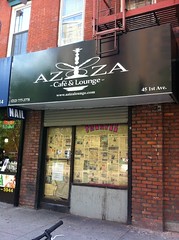 Daniel Maurer
Daniel MaurerThe former home of Dana Falafel Shawarma Deli will be offering falafel again – and flavored tobacco, as well. In the next weeks, a hookah lounge will open in the modest storefront at 45 First Avenue, near Third Street.
Stu El-Boghdedy, the manager of the forthcoming Aziza (a girl’s name meaning “beloved” in Arabic) gave The Local a sneak peek into the 35-seat lounge decorated with Moroccan lanterns, fabrics and poufs. In addition to Egyptian water pipes, he said, he’ll be serving light appetizers such as hummus, falafel, grape leaves, and eggplant salad as well as non-alcoholic drinks such as Turkish coffee, mint tea served in ornate teapots, and salep, a sweet, hot milk drink.
Mr. El-Boghdedy said hookahs would go from $12 to $35 or $40, which raised the question: why are water pipes at the East Village’s numerous smoke dens so expensive, anyway? Read more…
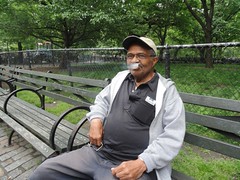 Stephen Rex Brown Damaso Vigo takes a defiant puff.
Stephen Rex Brown Damaso Vigo takes a defiant puff.As you probably heard, smoking is now banned in city parks and beaches. The Local stopped by Tompkins Square Park to see if East Village smokers were following the letter of the law.
The first thing we saw upon entering the park at St. Marks Place? That’s right, a smoking scofflaw.
“You can’t even smoke in the park? Then where you going to smoke?” said Damaso Vigo, in between puffs of a Tiparillo Mild cigar. “It’s a stupid thing.”
The new law was hailed by Mayor Michael R. Bloomberg as an important measure to protect locals’ lungs.
“The science is clear: prolonged exposure to secondhand smoke, whether you’re indoors or out, hurts your health,” the mayor said in a statement. “Today, we’re doing something about it.”
But even some non-smokers in Tompkins Square Park were uneasy with the nix on nicotine in parks.
Read more…
 Stephen Morgan
Stephen Morgan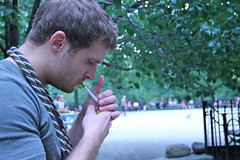 Stephen Morgan
Stephen Morgan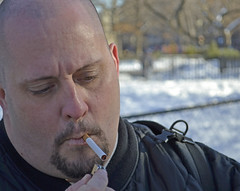 Mark Riffee The city’s expanded smoking ban applies to city parks, including Tompkins Square Park where these smokers were lighting up.
Mark Riffee The city’s expanded smoking ban applies to city parks, including Tompkins Square Park where these smokers were lighting up.When City Council members voted the other day for Mayor Michael Bloomberg’s latest anti-smoking bill there was urgent debate for and against the legislation, which bans cigarette smoking in all New York City parks, certain public “plazas” (Times Square, for instance), and on all of its public beaches. Some Councilmen considered the bill to be a vital public health measure. Others, like Manhattan’s Robert Jackson, warned that such laws move us toward “a totalitarian society.”
But no worries. If Mr. Bloomberg signs the bill as expected, East Villagers will be able to enjoy the sanctuary of Tompkins Square Park this summer – safe in the knowledge that they can sit on a bench and talk for hours on cell phones, bang on bongos until sundown, or practice their scales on a tuneless guitar while others are trying to read – without even a wisp of silent smoke to poison their cacophonous idylls.
And if smokers do wish to smoke, they may leave the park, as if it were an unusually large restaurant, and indulge themselves on the periphery. In time, the subsequent clotting and befouling of the sidewalks around the park might understandably irritate pedestrians, thus leading to a new ban. Eventually, smokers may be forced to take their chances and light up in the middle of the road.
It is undeniable that smoking is harmful to one’s health and there is ample evidence that smokers can indeed quit. Well, at least some of them can. Perhaps even most. But certainly not all. Certain stubborn souls just can’t, or won’t, shake the habit. Then there are schizophrenics, the bipolar types, the deeply depressed, and others to whom cigarettes are a crucial crutch.
Read more…
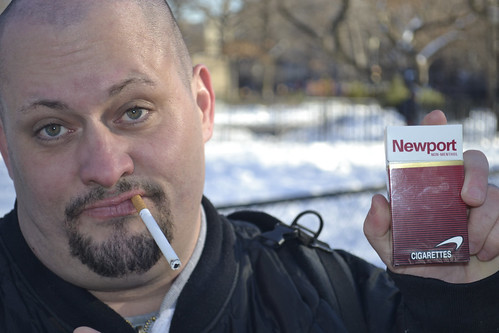 Mark Riffee City Council voted Wednesday to extend the smoking ban to parks and beaches. Jon Goldstein, an East Village tattoo artist, thinks the law was passed in order to make money from fines.
Mark Riffee City Council voted Wednesday to extend the smoking ban to parks and beaches. Jon Goldstein, an East Village tattoo artist, thinks the law was passed in order to make money from fines.No smoking allowed in New York City’s 1,700 parks or along the city’s 14 miles of beaches, said the City Council on Wednesday. The measure passed by 36-to-12 after a bitter debate over government authority versus individual liberties.
So what do you think, East Village?
“I think it’s ludicrous,” said Jon Goldstein, a 39-year-old tattoo artist. “It’s just a way for them to make money. They can’t tax any more stuff so they just start adding fines. You know what’s going to happen?” he asked, lighting up in Tomkins Square Park while he still can. “The police are going to be so overwhelmed with ticketing people who are smoking and not really paying attention to what they should be paying attention to.”
Read more…
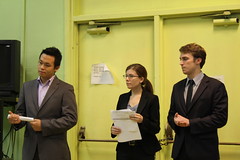 Tania Barnes Supporters of the anti-smoking measure address Community Board 3 Thursday night. One board member called the plan “over-legislation.”
Tania Barnes Supporters of the anti-smoking measure address Community Board 3 Thursday night. One board member called the plan “over-legislation.”Smoking is allowed here – that was the message Community Board 3 sent to anti-smoking groups Thursday night by refusing to endorse legislation that would broaden the city’s ban on smoking in public.
Staff from the American Lung Association in New York and Asian Americans for Equality asked the board for a resolution supporting City Councilwoman Gale Brewer’s proposed expansion of the smoking ban. In their request, the anti-smoking groups cited the high rates of smoking in the district: 18.3 percent vs. 15.6 percent citywide.
Councilwoman Brewer’s proposal would extend the existing ban at restaurants and bars to such outdoor locations as parks and beaches.
The resolution from the board would have largely been a symbolic gesture: it would indicate to City Council that the district’s leadership supported the legislation.
But when asked if they wanted to make a motion, board members were conspicuously silent. A motion must be made before a vote on a resolution can take place: no motion, no resolution.
“The government is crossing the line – it’s over-legislation,” Community Board member Tom Parker said in an interview after the meeting, explaining his refusal to support the resolution. “Look, both my parents died of smoking. But it’s an outdoor activity. Where are people supposed to go?”
Still, Lisa Spitzner, of the American Lung Association in New York, remained optimistic, saying that one of the group’s main goals Thursday night was to get the word out to the community about smoking cessation programs. “This is the best way to do it,” she said.
What do you think about the plan to extend the smoking ban?
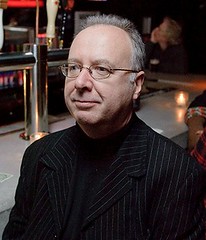 Kim Davis.
Kim Davis.What legitimate expectations does the community have of bar and club-owners when it comes to noise? And just which community are we talking about? I wanted to remove my editorial hat for a moment and join this conversation from a personal perspective.
Of course we can have legitimate expectations when it comes to how the nightlife industry conducts itself. The owners should be held responsible for behavior inside bars and clubs, for the level of noise emanating from the premises, and for what happens right on their doorstep. In particular, they should be held accountable if they serve liquor to guests who are already intoxicated: illegal, of course, but a law hardly ever enforced.
They cannot, however, be held responsible for policing the streets of the East Village. It was the city, remember, who decided that smokers should congregate outside licensed premises, with the result that late-night conversations once held behind closed doors are now held on the sidewalk.
Beyond posting friendly reminders to keep the noise down, what can bar and club owners do? They have no authority to impose silence on the streets; they can’t control the behavior of customers who have left their premises; and they certainly can’t stop cabs sounding their horns.
But just who is being disturbed by late-night street life? I’ve lived between Avenues C and D for ten years, and my neighbors aren’t complaining about noise from clubs. They can’t hear it over the music they’re blasting themselves. What’s more, long-term residents of the blocks east of Avenue A are for the most part happy to see bright lights and nightlife replace the dark storefronts of the past. As the urbanist Jane Jacobs taught, empty, silent streets are hospitable to criminality.
Is it noise that’s really what bothers some segments of the community? Or is it change? Is it the sense that the people making the noise (visitors to the neighborhood, students) don’t really belong? Is this supposed issue really a peg on which to hang prejudices and a sort of inverted snobbery: keep out of my East Village – you’re not welcome?
Kim Davis is the community editor of The Local East Village.











